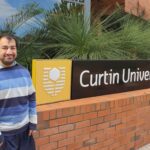In November 2017 Australia said ‘yes’ to same-sex marriage and writ into law the right for all people, regardless of gender, to celebrate love and partake in one of humanity’s oldest traditions. A few months later Indonesia, one of our closest neighbours, declared homosexuality a mental disorder.
While LGBTIQA+ rights have gained ground in Australia and globally, there has been a coeval rise in homophobia, biphobia, transphobia and intersexism, and research is showing this contradictory landscape is especially evident in South-East Asia.
In an age of global connectedness and increasing advocacy that asserts LGBTIQA+ rights are human rights, how can there be such contrast both between and within countries when it comes to representation of gender, sexuality and bodies?
“Marriage equality is just one factor – it doesn’t mean the end of problems for LGBTIQA+ people,” says Professor Baden Offord, an internationally-recognised human rights researcher and Director of Curtin’s Centre for Human Rights Education.
Offord is conducting a ‘pulse check’ of LGBTIQA+ rights in South-East Asia, in collaboration with researchers from Deakin, Monash and Flinders universities. Through this research, Offord and his team have observed striking variations in the way South-East Asian countries approach and practice the rights of LGBTIQA+ people.
“At the regional level, the diversity of stances is clearly seen in debates between member states over ‘Asian values’, while at the national level approaches to LGBTIQA+ issues have been exceptionally varied and, often, on the surface at least, seemingly contradictory,” he says.
For example, in Aceh, Indonesia, public whipping is a common punishment for those found guilty of same-sex sexual relations, yet such relations are legal elsewhere in the country. In Singapore, sex between people of the same gender is still illegal, but its annual Pink Dot event, which celebrates the Singaporean LGBTIQA+ community, attract tens of thousands of participants and industry sponsorship. India decriminalised same-sex sexual relations in 2018, but the stigma surrounding homosexuality and bisexuality prevents many individuals, particularly those living in rural areas, from publicly ‘coming out’.
“These examples, as well as extensive reports about the discrimination, marginalisation and violence experienced by LGBTIQA+ people in the countries of Southeast Asia, point to the reality that, in practice, recognition of LGBTIQA+ people’s human rights is uneven, incomplete and frequently contradictory and arbitrary,” Offord says.
“This in turn means that the utility of any one model for progress is limited, since it cannot account for all aspects of a complex and multifaceted situation.”
That ‘one model’ is the Western template that is often used to examine and assess a country’s progress in LGBTIQA+ rights. Offord says that the temptation by some human rights activists and researchers to apply a ‘one-size-fits-all’ approach is beset with error and the potential for regression.
“Human rights is a very complex thing, and even though the Western framework has become a sort of ‘moral blue print’, it can be problematic.
“Eurocentrism has the potential to skew both expectations and interpretations, suggesting that there is a ‘right’ way to achieve recognition, rather than developing strategies that are responsive to local contingencies and dynamics.”
Indeed, LGBTIQA+ advocacy in some non-Western countries has been used by states opposing gender and sexual diversity as evidence of a neo-colonialist scheme at work, and is responded to with open hostility and repression (see for example Russia’s gay propaganda law, and proposed changes to Indonesia’s penal code).
But in Western countries, too, there has been mounting reactionary opposition to LGBTIQA+ discourse as gender equality becomes more mainstream.
Perhaps when fundamental concepts such as ‘male’ and ‘female’ are questioned, they uncomfortably call for the examination of all the seemingly inherent qualities that make us, us.
“Every culture in society goes through its own self-reflection, in a sense. LGBTIQA+ issues are not the first instance of transformation,” Offord says, who cites women’s rights and the rights of people with disabilities as other examples.
“I think backlash occurs because people fear change. It’s about being in a bubble and suddenly finding the world very different when the oppressed speak out.”
Offord’s current research is focused on developing a decolonising framework for examining the rights of LGBTIQA+ people in South-East Asia – one that takes into account local, societal, political, legal and cultural dynamics, and can therefore highlight the specific needs and interests of LGBTIQA+ communities.
“The human rights framework offers a valuable way to talk about how to live in a world of strangers, who may have different beliefs, attitudes, ideas and ways to our own.
“How do we all get along with each other and sit at the same table?”
The hope is that this framework could be adopted by the Australia government to engage in protection and promotion of the rights of LGBTIQA+ people across South-East Asia and the Pacific. Beyond the political sphere, Offord says we can all take steps to navigate differences in ideologies and identities in our daily lives.
“Making a connection with another person is a good place to start. It’s about listening to their individual story, having empathy and suspending judgement,” he advises.
“It’s got to be one-on-one encounters, and then a building up of trust. It’s about being able to educate oneself and learning about a person’s lived experience.”
Because in the end you might find that the ‘other’ is really just another you and me.



